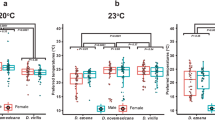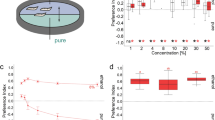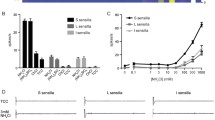Abstract
Two alleles of the mutant lozengeof Drosophila melanogaster, lzand lz3,lack basiconic sensilla on the antennal funiculus. To elucidate the role of these sensilla for the perception of food odors, we studied the locomotor behavior and the electroantennogram (EAG) activity of lozenge flies in response to olfactory stimuli. The significance of basiconic sensilla on the maxillary palps was assessed by testing the locomotion of flies surgically deprived of their palps. The behavioral data suggest that antennal and maxillary basiconic sensilla may be important receptors for short chain alcohols and organic acids but less crucial receptors for acetates, aldehydes, and ketones. In agreement with this interpretation, EAG responses to alcohols (but not to esters) were found to be markedly lower in lozengethan in the wild type.
Similar content being viewed by others
References
Altner, H., and Prillinger, L. (1980). Ultrastructure of invertebrate chemo-, thermo-, and hygroreceptors and its functional significance.Int. Rev. Cytol. 67: 69–139.
Ayyub, C., Paranjape, J., Rodrigues, V., and Siddiqi, O. (1990). Genetics of olfactory behavior inDrosophila melanogaster.J. Neurogenet. 6: 243–262.
Benzer, S. (1967). Behavioral mutants ofDrosophila isolated by counter-current distribution.Proc. Natl. Acad. Sci. USA 58: 1112–1119.
Boekhoff, I., Tareilus, E., Strotmann, J., and Breer, H. (1990). Rapid activation of alternative second messenger pathways in olfactory cilia from rats by different odorants.EMBO J. 9: 2453–2458.
Borst, A. (1984). Identification of different chemoreceptors by electroantennogram recording.J. Insect Physiol. 30: 507–510.
Boulétrau, M., and Feuillet, P. (1981). An accurate and reliable olfactometer.Dros. Inf. Serv. 56: 172–174.
Davies, J., Pirrotta, V., and Miklos, G. L. G. (1987). Analysis of theshaking B locus ofD. melanogaster.J. Neurogenet. 4: 123.
Etcheto, M. (1980). A constant flow rate olfactometer with seven calibrated concentrations.Chem. Senses 5: 1–9.
Fuyama, Y. (1976). Behavior genetics of olfactory responses inDrosophila. I. Olfactometry and strain differences inDrosophila melanogaster.Behav. Genet. 6: 407–420.
Lienhard, M. C., and Stocker, R. F. (1991). The development of the sensory neuron pattern in the antennal disc of wild-type and mutant (lz3, ssa)Drosophila melanogaster. Development112 (in press).
Link, B. (1983).Raster-und transmissionselektronenmikroskopische Analyse der Sensillen des mesothorakalen Beines und des dritten Antennensegmentes von Drosophila melanogaster, Diploma thesis, University of Fribourg, Fribourg, Switzerland.
McKenna, M., Monte, P., Helfand, S. L., Woodard, C., and Carlson, J. (1989). A simple chemosensory response inDrosophila and the isolation ofacj mutations in which it is affected.Proc. Natl. Acad. Sci. USA 86: 8118–8122.
Rodrigues, V. (1980). Olfactory behavior ofDrosophila melanogaster. In Siddiqi, O., Babu, B., Hall, L., and Hall, J. C. (eds.), Plenum Press, New York, pp. 361–371.
Rodrigues, V. (1988). Spatial coding of olfactory information in the antennal lobe ofDrosophila melanogaster.Brain Res. 453: 299–307.
Schaller, L. (1982). Structural and functional classification of antennal sensilla of the cockroach,Leucophaea maderae.Cell Tissue Res. 225: 129–142.
Siddiqi, O. (1984). Olfactory neurogenetics ofDrosophila. In Chopra, V. L., Joshi, B. C., Sharma, R. P., and Bawal, H. C. (eds.),Genetics: New Frontiers, Vol. III, Oxford University Press and IBH, London and New York, pp. 242–261.
Siddiqi, O. (1987). Neurogenetics of olfaction inDrosophila melanogaster.Trends Genet. 3: 137–142.
Singh, R. N., and Nayak S. V. (1985). Fine structure and primary sensory projections of sensilla on the maxillary palp ofDrosophila melanogaster Meigen (Diptera: Drosophilidae).Int. J. Insect Morphol. Embryol. 14: 291–306.
Steinbrecht, R. A. (1987). Functional morphology of pheromone-sensitive sensilla. In Prestwich, G. D., and Blomquist, G. J. (eds.),Pheromone Biochemistry, Academic Press, New York, pp. 353–384.
Stocker, R. F., and Gendre, N. (1988). Peripheral and central nervous effects oflozenge 3: ADrosophila mutant lacking basiconic antennal sensilla.Dev. Biol. 127: 12–24.
Stocker, R. F., and Gendre, N. (1989). Courtship behavior ofDrosophila, genetically or surgically deprived of basiconic sensilla.Behav. Genet. 19: 371–385.
Stocker, R. F., Singh, R. N., Schorderet, M., and Siddiqi, O. (1983). Projection patterns of different types of antennal sensilla in the antennal glomeruli ofDrosophila melanogaster.Cell Tissue Res. 232: 237–248.
Stocker, R. F., Lienhard, M. C., Borst, A., and Fischbach, K. F. (1990). Neuronal architecture of the antennal lobe inDrosophila melanogaster.Cell Tissue Res. 262:9–34.
Thomas, J. B., and Wyman, R. J. (1982). A mutation inDrosophila melanogaster alters normal connectivity between two identified neurons.Nature 298: 650–651.
Thomas, J. B., and Wyman, R. J. (1984). Mutations altering synaptic connectivity between identified neurons inDrosophila.J. Neurosci. 4: 530–538.
Venard, R., and Pichon, Y. (1981). Etude électroantennographique de la réponse périphérique de l'antenne deDrosophila melanogaster faite à l'aide de stimulations odorantes.C.R. Acad. Sci. Paris 293: 839–842.
Venard, R., and Pichon, Y. (1984). Electrophysiological analysis of the peripheral response to odours in wild type and smell-deficientolf C mutant ofDrosophila melanogaster.J. Insect Physiol. 30: 1–5.
Venard, R., Antony, C., and Jallon, J.-M. (1989).Drosophila chemoreceptors. In Singh, R. N., and Strausfeld, N. J. (eds.),Neurobiology of Sensory Systems, Plenum, New York and London, pp. 377–385.
Venkatesh, S., and Singh, R. N. (1984). Sensilla on the third antennal segment ofDrosophila melanogaster Meigen (Diptera: Drosophilidae).Int. J. Insect Morphol. Embryol. 13: 51–63.
Woodard, C., Huang, T., Sun, H., Helfand, S. L., and Carlson, (1989). Genetic analysis of olfactory behavior in Drosophila — A new screen yields the mutants.Genetics 123: 315–326.
Author information
Authors and Affiliations
Rights and permissions
About this article
Cite this article
Venard, R., Stocker, R.F. Behavioral and electroantennogram analysis of olfactory stimulation inlozenge: ADrosophila mutant lacking antennal basiconic sensilla (Diptera: Drosophilidae). J Insect Behav 4, 683–705 (1991). https://doi.org/10.1007/BF01052225
Accepted:
Issue Date:
DOI: https://doi.org/10.1007/BF01052225




